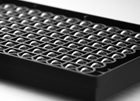 Spheroid microplates with ULA surface for spheroid and organoid cultures
Spheroid microplates with ULA surface for spheroid and organoid cultures
In vitro 3D cell culture models are widely recognised as more physiologically relevant systems compared to 2D formats. The 3D models reflect more accurately the complex in vivo microenvironment and have been used in many research areas, such as cancer biology, hepatotoxicity, neurology, pancreatic studies, nephrology, and stem cell biology. These studies have revolutionised our understanding of cellular behaviour both in culture and in vivo. However, adoption of 3D cell culture models in high throughput screening (HTS) platforms has been slow due to the limitations of the current technologies. Problems include increased variability, low throughput, difficulty to automate, and high cost.
Corning® spheroid microplates are multiwell, cell culture plates with opaque walls and clear, round well-bottom geometry. The proprietary Corning Ultra-Low Attachment (ULA) surface coating, which is hydrophilic, biologically inert and non-degradable, is covalently attached to the interior surface of the well-bottom. The unique design of the well-bottom enables highly reproducible growth of 3D cell spheroid cultures. The opaque side walls and proprietary gridded plate bottom design reduce well-to-well cross-talk and background fluorescence/luminescence. Spheroids may be generated, cultured, and assayed for fluorescent or luminescent signals in the same plate without the need for transferring the spheroids. Corning spheroid microplates are available in automation friendly format of 96-well and 384-well.
Application Notes and Protocols

Scientific Poster
Find out the Hight-throughput Assays for Characterizing the Viability and Morphology of the 3D Cancer Spheroid Cultures.